BUSN20017: Reflective Essay on Business Communication Skills
VerifiedAdded on 2023/06/04
|10
|2874
|296
Essay
AI Summary
This reflective essay, written for the BUSN20017 Effective Business Communication course, explores various communication concepts and their practical applications. The essay begins with an introduction emphasizing the critical role of communication in society and the importance of understanding its nuances. The student reflects on key concepts learned over ten weeks, including communication competence, nonverbal communication, written communication, plagiarism, reflective essay writing, public speaking, cross-cultural communication, organizational structure, teamwork, and aggressive communication. The essay delves into each concept, providing personal insights and examples of how these concepts impact daily interactions and professional settings. The student connects these learnings to future career aspirations, particularly in leadership roles, highlighting the importance of effective communication in presentations, team management, and conflict resolution. The essay also references academic literature to support the student's reflections, demonstrating a comprehensive understanding of the course material and its practical relevance. The essay concludes by reiterating the significance of communication skills for personal and professional success.
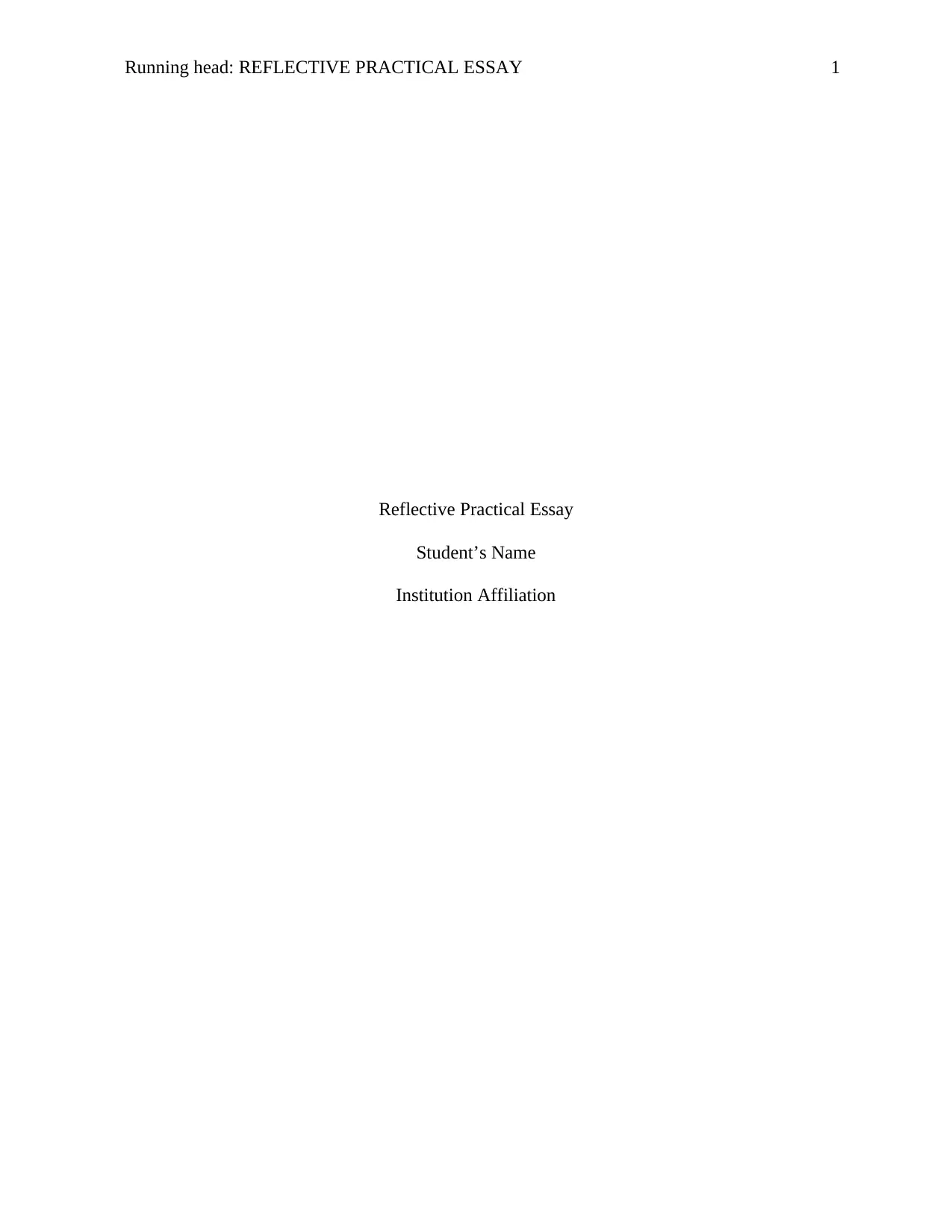
Running head: REFLECTIVE PRACTICAL ESSAY 1
Reflective Practical Essay
Student’s Name
Institution Affiliation
Reflective Practical Essay
Student’s Name
Institution Affiliation
Paraphrase This Document
Need a fresh take? Get an instant paraphrase of this document with our AI Paraphraser
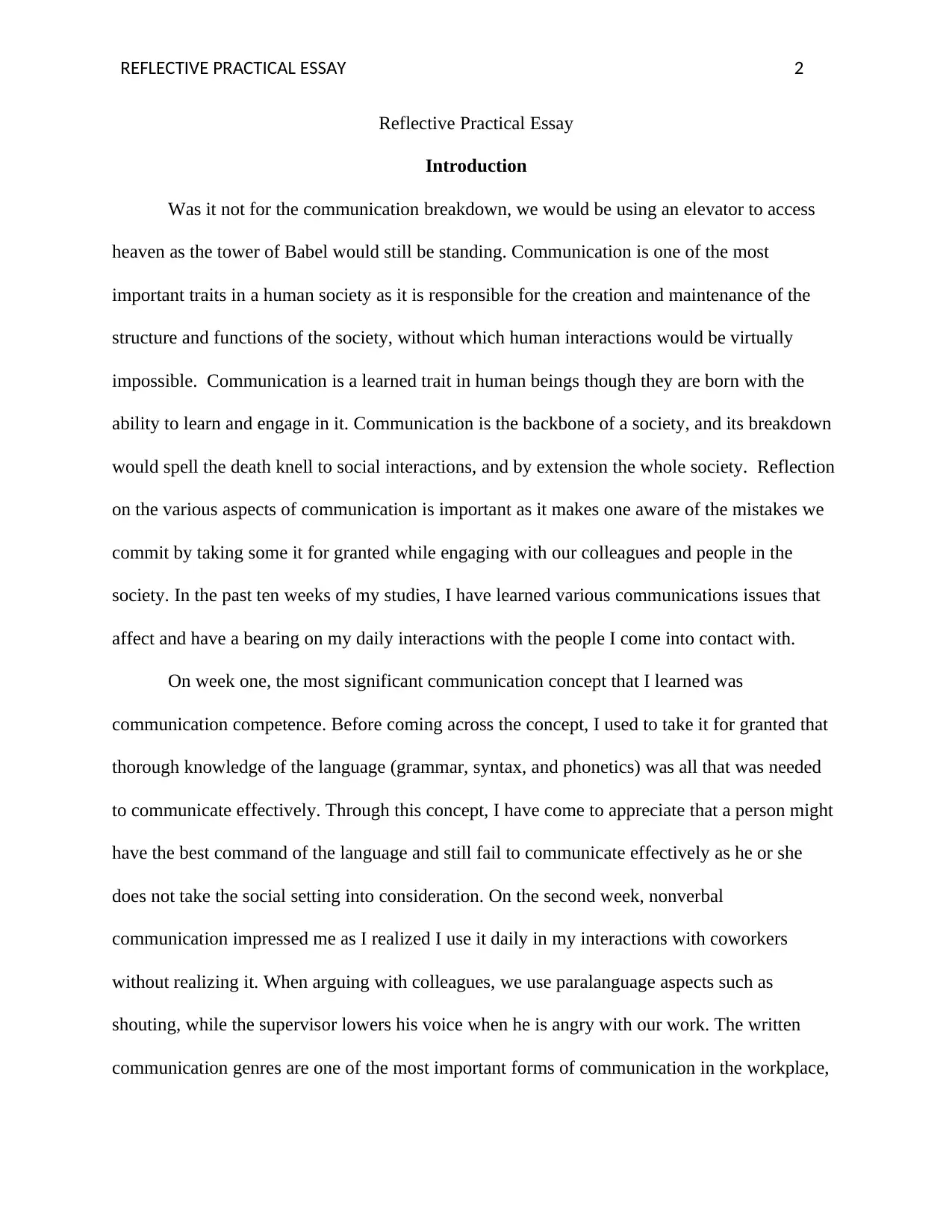
REFLECTIVE PRACTICAL ESSAY 2
Reflective Practical Essay
Introduction
Was it not for the communication breakdown, we would be using an elevator to access
heaven as the tower of Babel would still be standing. Communication is one of the most
important traits in a human society as it is responsible for the creation and maintenance of the
structure and functions of the society, without which human interactions would be virtually
impossible. Communication is a learned trait in human beings though they are born with the
ability to learn and engage in it. Communication is the backbone of a society, and its breakdown
would spell the death knell to social interactions, and by extension the whole society. Reflection
on the various aspects of communication is important as it makes one aware of the mistakes we
commit by taking some it for granted while engaging with our colleagues and people in the
society. In the past ten weeks of my studies, I have learned various communications issues that
affect and have a bearing on my daily interactions with the people I come into contact with.
On week one, the most significant communication concept that I learned was
communication competence. Before coming across the concept, I used to take it for granted that
thorough knowledge of the language (grammar, syntax, and phonetics) was all that was needed
to communicate effectively. Through this concept, I have come to appreciate that a person might
have the best command of the language and still fail to communicate effectively as he or she
does not take the social setting into consideration. On the second week, nonverbal
communication impressed me as I realized I use it daily in my interactions with coworkers
without realizing it. When arguing with colleagues, we use paralanguage aspects such as
shouting, while the supervisor lowers his voice when he is angry with our work. The written
communication genres are one of the most important forms of communication in the workplace,
Reflective Practical Essay
Introduction
Was it not for the communication breakdown, we would be using an elevator to access
heaven as the tower of Babel would still be standing. Communication is one of the most
important traits in a human society as it is responsible for the creation and maintenance of the
structure and functions of the society, without which human interactions would be virtually
impossible. Communication is a learned trait in human beings though they are born with the
ability to learn and engage in it. Communication is the backbone of a society, and its breakdown
would spell the death knell to social interactions, and by extension the whole society. Reflection
on the various aspects of communication is important as it makes one aware of the mistakes we
commit by taking some it for granted while engaging with our colleagues and people in the
society. In the past ten weeks of my studies, I have learned various communications issues that
affect and have a bearing on my daily interactions with the people I come into contact with.
On week one, the most significant communication concept that I learned was
communication competence. Before coming across the concept, I used to take it for granted that
thorough knowledge of the language (grammar, syntax, and phonetics) was all that was needed
to communicate effectively. Through this concept, I have come to appreciate that a person might
have the best command of the language and still fail to communicate effectively as he or she
does not take the social setting into consideration. On the second week, nonverbal
communication impressed me as I realized I use it daily in my interactions with coworkers
without realizing it. When arguing with colleagues, we use paralanguage aspects such as
shouting, while the supervisor lowers his voice when he is angry with our work. The written
communication genres are one of the most important forms of communication in the workplace,
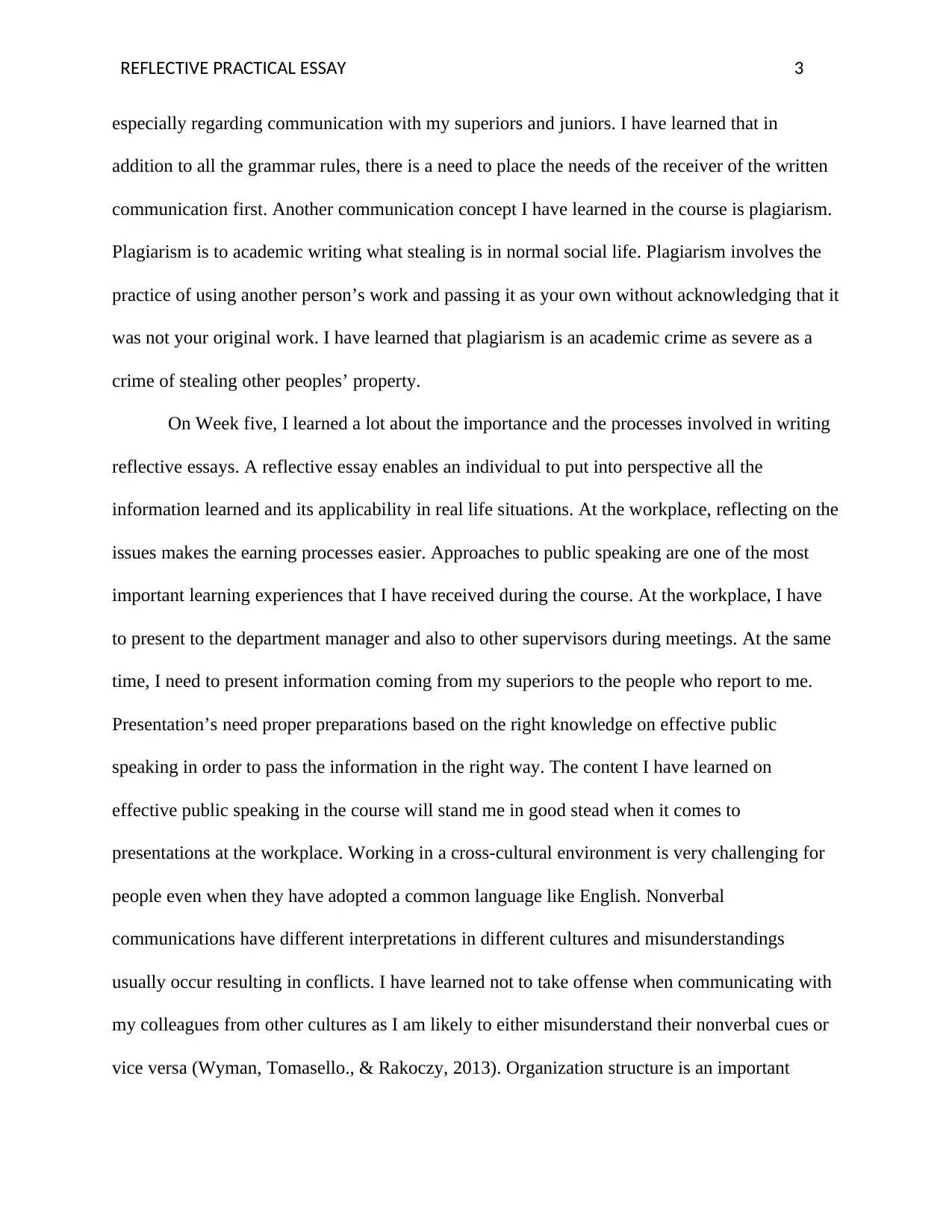
REFLECTIVE PRACTICAL ESSAY 3
especially regarding communication with my superiors and juniors. I have learned that in
addition to all the grammar rules, there is a need to place the needs of the receiver of the written
communication first. Another communication concept I have learned in the course is plagiarism.
Plagiarism is to academic writing what stealing is in normal social life. Plagiarism involves the
practice of using another person’s work and passing it as your own without acknowledging that it
was not your original work. I have learned that plagiarism is an academic crime as severe as a
crime of stealing other peoples’ property.
On Week five, I learned a lot about the importance and the processes involved in writing
reflective essays. A reflective essay enables an individual to put into perspective all the
information learned and its applicability in real life situations. At the workplace, reflecting on the
issues makes the earning processes easier. Approaches to public speaking are one of the most
important learning experiences that I have received during the course. At the workplace, I have
to present to the department manager and also to other supervisors during meetings. At the same
time, I need to present information coming from my superiors to the people who report to me.
Presentation’s need proper preparations based on the right knowledge on effective public
speaking in order to pass the information in the right way. The content I have learned on
effective public speaking in the course will stand me in good stead when it comes to
presentations at the workplace. Working in a cross-cultural environment is very challenging for
people even when they have adopted a common language like English. Nonverbal
communications have different interpretations in different cultures and misunderstandings
usually occur resulting in conflicts. I have learned not to take offense when communicating with
my colleagues from other cultures as I am likely to either misunderstand their nonverbal cues or
vice versa (Wyman, Tomasello., & Rakoczy, 2013). Organization structure is an important
especially regarding communication with my superiors and juniors. I have learned that in
addition to all the grammar rules, there is a need to place the needs of the receiver of the written
communication first. Another communication concept I have learned in the course is plagiarism.
Plagiarism is to academic writing what stealing is in normal social life. Plagiarism involves the
practice of using another person’s work and passing it as your own without acknowledging that it
was not your original work. I have learned that plagiarism is an academic crime as severe as a
crime of stealing other peoples’ property.
On Week five, I learned a lot about the importance and the processes involved in writing
reflective essays. A reflective essay enables an individual to put into perspective all the
information learned and its applicability in real life situations. At the workplace, reflecting on the
issues makes the earning processes easier. Approaches to public speaking are one of the most
important learning experiences that I have received during the course. At the workplace, I have
to present to the department manager and also to other supervisors during meetings. At the same
time, I need to present information coming from my superiors to the people who report to me.
Presentation’s need proper preparations based on the right knowledge on effective public
speaking in order to pass the information in the right way. The content I have learned on
effective public speaking in the course will stand me in good stead when it comes to
presentations at the workplace. Working in a cross-cultural environment is very challenging for
people even when they have adopted a common language like English. Nonverbal
communications have different interpretations in different cultures and misunderstandings
usually occur resulting in conflicts. I have learned not to take offense when communicating with
my colleagues from other cultures as I am likely to either misunderstand their nonverbal cues or
vice versa (Wyman, Tomasello., & Rakoczy, 2013). Organization structure is an important
⊘ This is a preview!⊘
Do you want full access?
Subscribe today to unlock all pages.

Trusted by 1+ million students worldwide
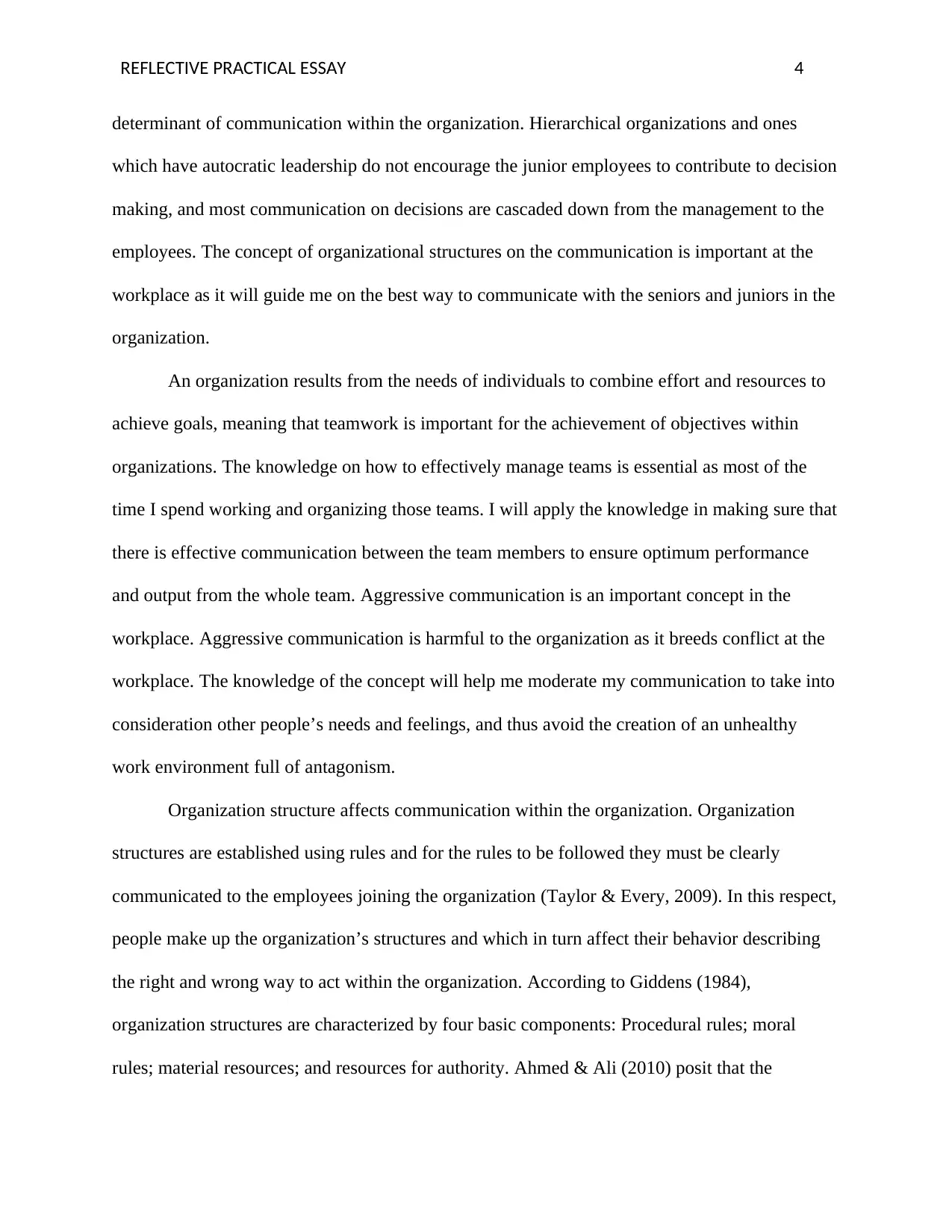
REFLECTIVE PRACTICAL ESSAY 4
determinant of communication within the organization. Hierarchical organizations and ones
which have autocratic leadership do not encourage the junior employees to contribute to decision
making, and most communication on decisions are cascaded down from the management to the
employees. The concept of organizational structures on the communication is important at the
workplace as it will guide me on the best way to communicate with the seniors and juniors in the
organization.
An organization results from the needs of individuals to combine effort and resources to
achieve goals, meaning that teamwork is important for the achievement of objectives within
organizations. The knowledge on how to effectively manage teams is essential as most of the
time I spend working and organizing those teams. I will apply the knowledge in making sure that
there is effective communication between the team members to ensure optimum performance
and output from the whole team. Aggressive communication is an important concept in the
workplace. Aggressive communication is harmful to the organization as it breeds conflict at the
workplace. The knowledge of the concept will help me moderate my communication to take into
consideration other people’s needs and feelings, and thus avoid the creation of an unhealthy
work environment full of antagonism.
Organization structure affects communication within the organization. Organization
structures are established using rules and for the rules to be followed they must be clearly
communicated to the employees joining the organization (Taylor & Every, 2009). In this respect,
people make up the organization’s structures and which in turn affect their behavior describing
the right and wrong way to act within the organization. According to Giddens (1984),
organization structures are characterized by four basic components: Procedural rules; moral
rules; material resources; and resources for authority. Ahmed & Ali (2010) posit that the
determinant of communication within the organization. Hierarchical organizations and ones
which have autocratic leadership do not encourage the junior employees to contribute to decision
making, and most communication on decisions are cascaded down from the management to the
employees. The concept of organizational structures on the communication is important at the
workplace as it will guide me on the best way to communicate with the seniors and juniors in the
organization.
An organization results from the needs of individuals to combine effort and resources to
achieve goals, meaning that teamwork is important for the achievement of objectives within
organizations. The knowledge on how to effectively manage teams is essential as most of the
time I spend working and organizing those teams. I will apply the knowledge in making sure that
there is effective communication between the team members to ensure optimum performance
and output from the whole team. Aggressive communication is an important concept in the
workplace. Aggressive communication is harmful to the organization as it breeds conflict at the
workplace. The knowledge of the concept will help me moderate my communication to take into
consideration other people’s needs and feelings, and thus avoid the creation of an unhealthy
work environment full of antagonism.
Organization structure affects communication within the organization. Organization
structures are established using rules and for the rules to be followed they must be clearly
communicated to the employees joining the organization (Taylor & Every, 2009). In this respect,
people make up the organization’s structures and which in turn affect their behavior describing
the right and wrong way to act within the organization. According to Giddens (1984),
organization structures are characterized by four basic components: Procedural rules; moral
rules; material resources; and resources for authority. Ahmed & Ali (2010) posit that the
Paraphrase This Document
Need a fresh take? Get an instant paraphrase of this document with our AI Paraphraser
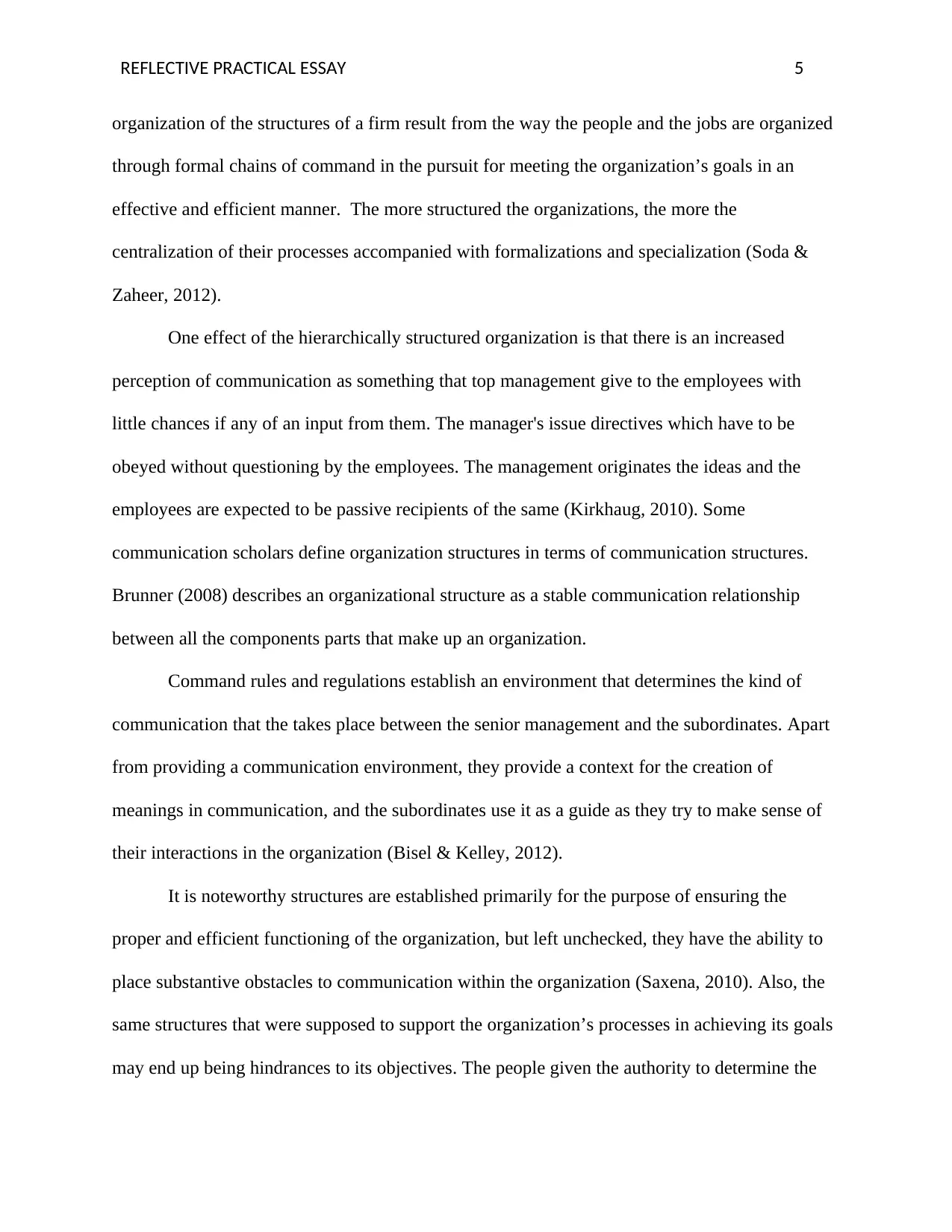
REFLECTIVE PRACTICAL ESSAY 5
organization of the structures of a firm result from the way the people and the jobs are organized
through formal chains of command in the pursuit for meeting the organization’s goals in an
effective and efficient manner. The more structured the organizations, the more the
centralization of their processes accompanied with formalizations and specialization (Soda &
Zaheer, 2012).
One effect of the hierarchically structured organization is that there is an increased
perception of communication as something that top management give to the employees with
little chances if any of an input from them. The manager's issue directives which have to be
obeyed without questioning by the employees. The management originates the ideas and the
employees are expected to be passive recipients of the same (Kirkhaug, 2010). Some
communication scholars define organization structures in terms of communication structures.
Brunner (2008) describes an organizational structure as a stable communication relationship
between all the components parts that make up an organization.
Command rules and regulations establish an environment that determines the kind of
communication that the takes place between the senior management and the subordinates. Apart
from providing a communication environment, they provide a context for the creation of
meanings in communication, and the subordinates use it as a guide as they try to make sense of
their interactions in the organization (Bisel & Kelley, 2012).
It is noteworthy structures are established primarily for the purpose of ensuring the
proper and efficient functioning of the organization, but left unchecked, they have the ability to
place substantive obstacles to communication within the organization (Saxena, 2010). Also, the
same structures that were supposed to support the organization’s processes in achieving its goals
may end up being hindrances to its objectives. The people given the authority to determine the
organization of the structures of a firm result from the way the people and the jobs are organized
through formal chains of command in the pursuit for meeting the organization’s goals in an
effective and efficient manner. The more structured the organizations, the more the
centralization of their processes accompanied with formalizations and specialization (Soda &
Zaheer, 2012).
One effect of the hierarchically structured organization is that there is an increased
perception of communication as something that top management give to the employees with
little chances if any of an input from them. The manager's issue directives which have to be
obeyed without questioning by the employees. The management originates the ideas and the
employees are expected to be passive recipients of the same (Kirkhaug, 2010). Some
communication scholars define organization structures in terms of communication structures.
Brunner (2008) describes an organizational structure as a stable communication relationship
between all the components parts that make up an organization.
Command rules and regulations establish an environment that determines the kind of
communication that the takes place between the senior management and the subordinates. Apart
from providing a communication environment, they provide a context for the creation of
meanings in communication, and the subordinates use it as a guide as they try to make sense of
their interactions in the organization (Bisel & Kelley, 2012).
It is noteworthy structures are established primarily for the purpose of ensuring the
proper and efficient functioning of the organization, but left unchecked, they have the ability to
place substantive obstacles to communication within the organization (Saxena, 2010). Also, the
same structures that were supposed to support the organization’s processes in achieving its goals
may end up being hindrances to its objectives. The people given the authority to determine the
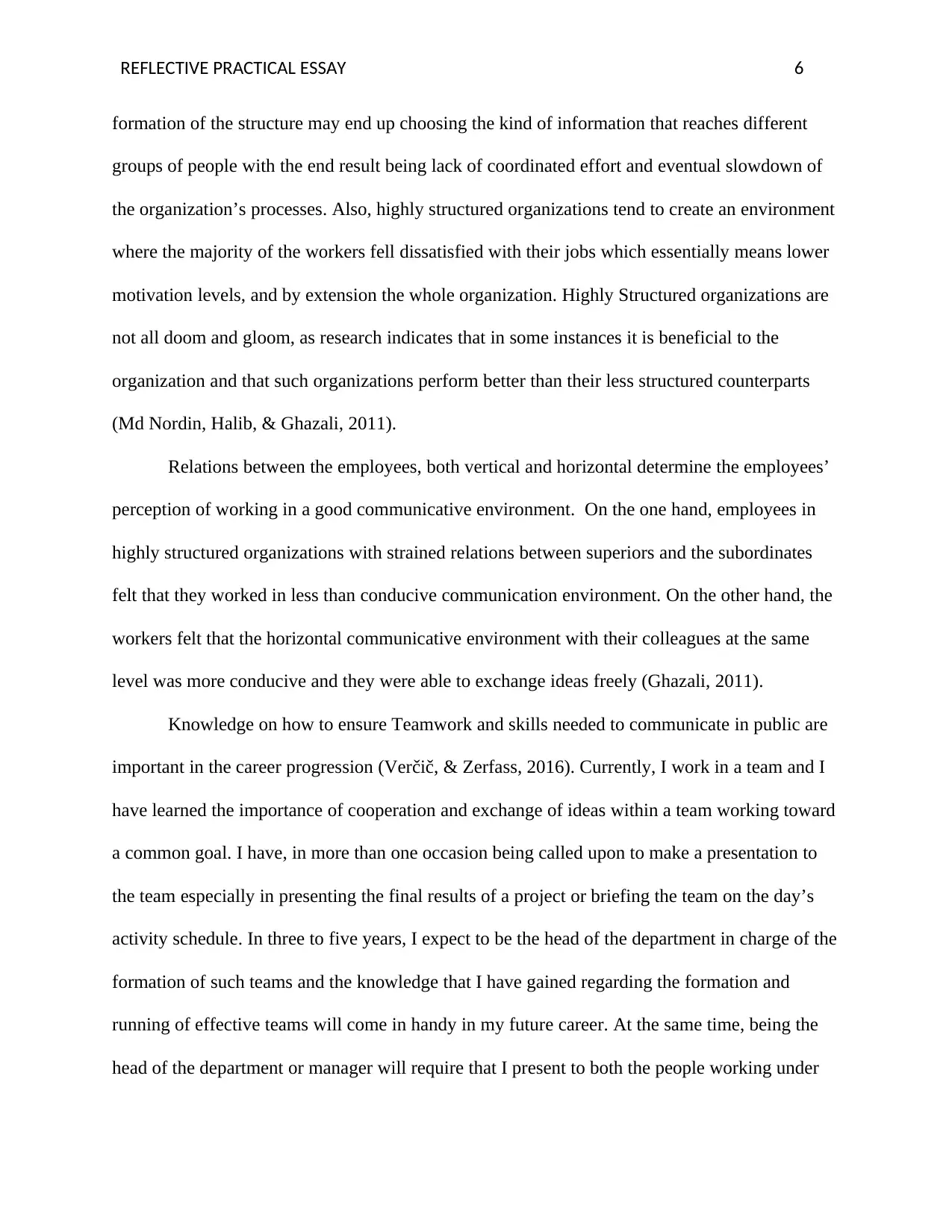
REFLECTIVE PRACTICAL ESSAY 6
formation of the structure may end up choosing the kind of information that reaches different
groups of people with the end result being lack of coordinated effort and eventual slowdown of
the organization’s processes. Also, highly structured organizations tend to create an environment
where the majority of the workers fell dissatisfied with their jobs which essentially means lower
motivation levels, and by extension the whole organization. Highly Structured organizations are
not all doom and gloom, as research indicates that in some instances it is beneficial to the
organization and that such organizations perform better than their less structured counterparts
(Md Nordin, Halib, & Ghazali, 2011).
Relations between the employees, both vertical and horizontal determine the employees’
perception of working in a good communicative environment. On the one hand, employees in
highly structured organizations with strained relations between superiors and the subordinates
felt that they worked in less than conducive communication environment. On the other hand, the
workers felt that the horizontal communicative environment with their colleagues at the same
level was more conducive and they were able to exchange ideas freely (Ghazali, 2011).
Knowledge on how to ensure Teamwork and skills needed to communicate in public are
important in the career progression (Verčič, & Zerfass, 2016) . Currently, I work in a team and I
have learned the importance of cooperation and exchange of ideas within a team working toward
a common goal. I have, in more than one occasion being called upon to make a presentation to
the team especially in presenting the final results of a project or briefing the team on the day’s
activity schedule. In three to five years, I expect to be the head of the department in charge of the
formation of such teams and the knowledge that I have gained regarding the formation and
running of effective teams will come in handy in my future career. At the same time, being the
head of the department or manager will require that I present to both the people working under
formation of the structure may end up choosing the kind of information that reaches different
groups of people with the end result being lack of coordinated effort and eventual slowdown of
the organization’s processes. Also, highly structured organizations tend to create an environment
where the majority of the workers fell dissatisfied with their jobs which essentially means lower
motivation levels, and by extension the whole organization. Highly Structured organizations are
not all doom and gloom, as research indicates that in some instances it is beneficial to the
organization and that such organizations perform better than their less structured counterparts
(Md Nordin, Halib, & Ghazali, 2011).
Relations between the employees, both vertical and horizontal determine the employees’
perception of working in a good communicative environment. On the one hand, employees in
highly structured organizations with strained relations between superiors and the subordinates
felt that they worked in less than conducive communication environment. On the other hand, the
workers felt that the horizontal communicative environment with their colleagues at the same
level was more conducive and they were able to exchange ideas freely (Ghazali, 2011).
Knowledge on how to ensure Teamwork and skills needed to communicate in public are
important in the career progression (Verčič, & Zerfass, 2016) . Currently, I work in a team and I
have learned the importance of cooperation and exchange of ideas within a team working toward
a common goal. I have, in more than one occasion being called upon to make a presentation to
the team especially in presenting the final results of a project or briefing the team on the day’s
activity schedule. In three to five years, I expect to be the head of the department in charge of the
formation of such teams and the knowledge that I have gained regarding the formation and
running of effective teams will come in handy in my future career. At the same time, being the
head of the department or manager will require that I present to both the people working under
⊘ This is a preview!⊘
Do you want full access?
Subscribe today to unlock all pages.

Trusted by 1+ million students worldwide
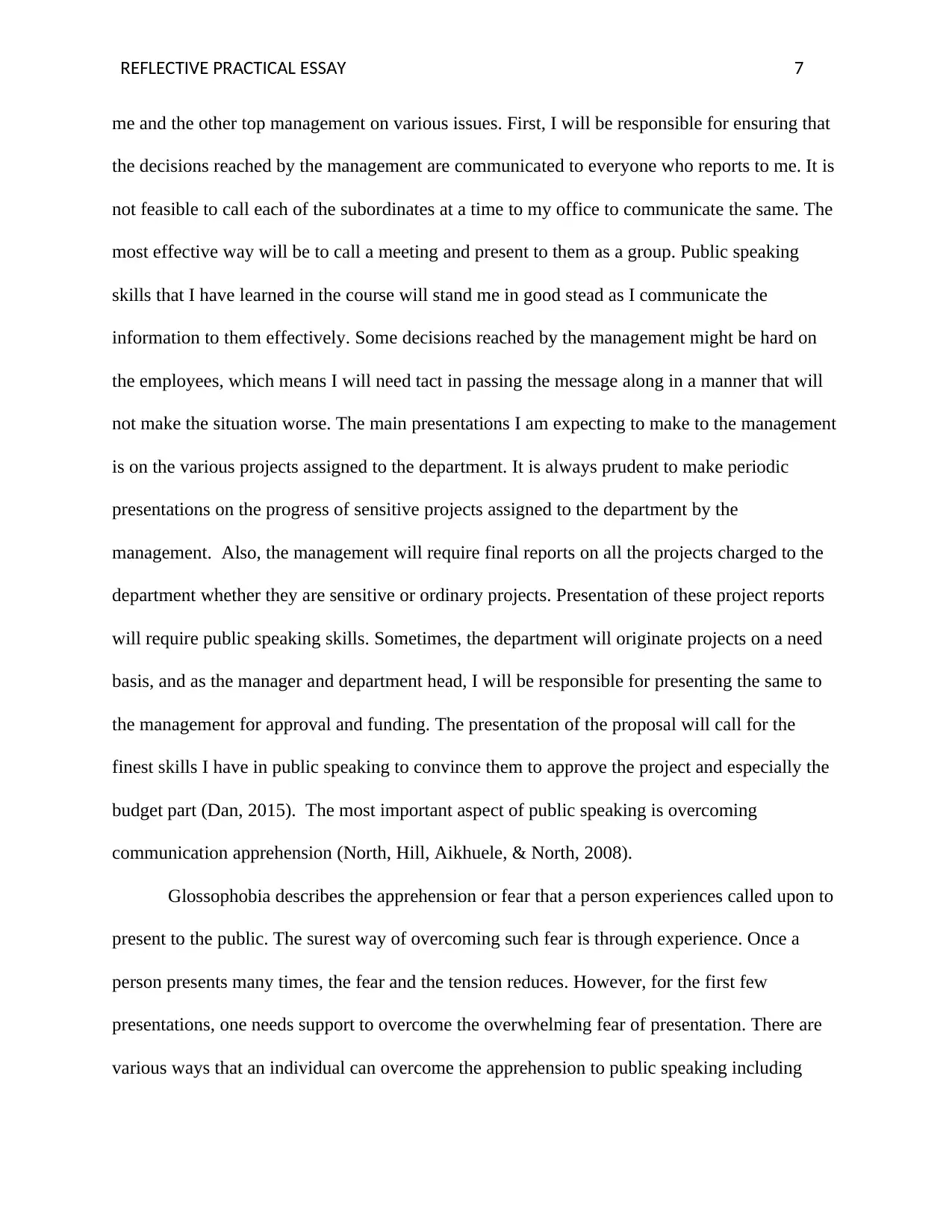
REFLECTIVE PRACTICAL ESSAY 7
me and the other top management on various issues. First, I will be responsible for ensuring that
the decisions reached by the management are communicated to everyone who reports to me. It is
not feasible to call each of the subordinates at a time to my office to communicate the same. The
most effective way will be to call a meeting and present to them as a group. Public speaking
skills that I have learned in the course will stand me in good stead as I communicate the
information to them effectively. Some decisions reached by the management might be hard on
the employees, which means I will need tact in passing the message along in a manner that will
not make the situation worse. The main presentations I am expecting to make to the management
is on the various projects assigned to the department. It is always prudent to make periodic
presentations on the progress of sensitive projects assigned to the department by the
management. Also, the management will require final reports on all the projects charged to the
department whether they are sensitive or ordinary projects. Presentation of these project reports
will require public speaking skills. Sometimes, the department will originate projects on a need
basis, and as the manager and department head, I will be responsible for presenting the same to
the management for approval and funding. The presentation of the proposal will call for the
finest skills I have in public speaking to convince them to approve the project and especially the
budget part (Dan, 2015). The most important aspect of public speaking is overcoming
communication apprehension (North, Hill, Aikhuele, & North, 2008).
Glossophobia describes the apprehension or fear that a person experiences called upon to
present to the public. The surest way of overcoming such fear is through experience. Once a
person presents many times, the fear and the tension reduces. However, for the first few
presentations, one needs support to overcome the overwhelming fear of presentation. There are
various ways that an individual can overcome the apprehension to public speaking including
me and the other top management on various issues. First, I will be responsible for ensuring that
the decisions reached by the management are communicated to everyone who reports to me. It is
not feasible to call each of the subordinates at a time to my office to communicate the same. The
most effective way will be to call a meeting and present to them as a group. Public speaking
skills that I have learned in the course will stand me in good stead as I communicate the
information to them effectively. Some decisions reached by the management might be hard on
the employees, which means I will need tact in passing the message along in a manner that will
not make the situation worse. The main presentations I am expecting to make to the management
is on the various projects assigned to the department. It is always prudent to make periodic
presentations on the progress of sensitive projects assigned to the department by the
management. Also, the management will require final reports on all the projects charged to the
department whether they are sensitive or ordinary projects. Presentation of these project reports
will require public speaking skills. Sometimes, the department will originate projects on a need
basis, and as the manager and department head, I will be responsible for presenting the same to
the management for approval and funding. The presentation of the proposal will call for the
finest skills I have in public speaking to convince them to approve the project and especially the
budget part (Dan, 2015). The most important aspect of public speaking is overcoming
communication apprehension (North, Hill, Aikhuele, & North, 2008).
Glossophobia describes the apprehension or fear that a person experiences called upon to
present to the public. The surest way of overcoming such fear is through experience. Once a
person presents many times, the fear and the tension reduces. However, for the first few
presentations, one needs support to overcome the overwhelming fear of presentation. There are
various ways that an individual can overcome the apprehension to public speaking including
Paraphrase This Document
Need a fresh take? Get an instant paraphrase of this document with our AI Paraphraser
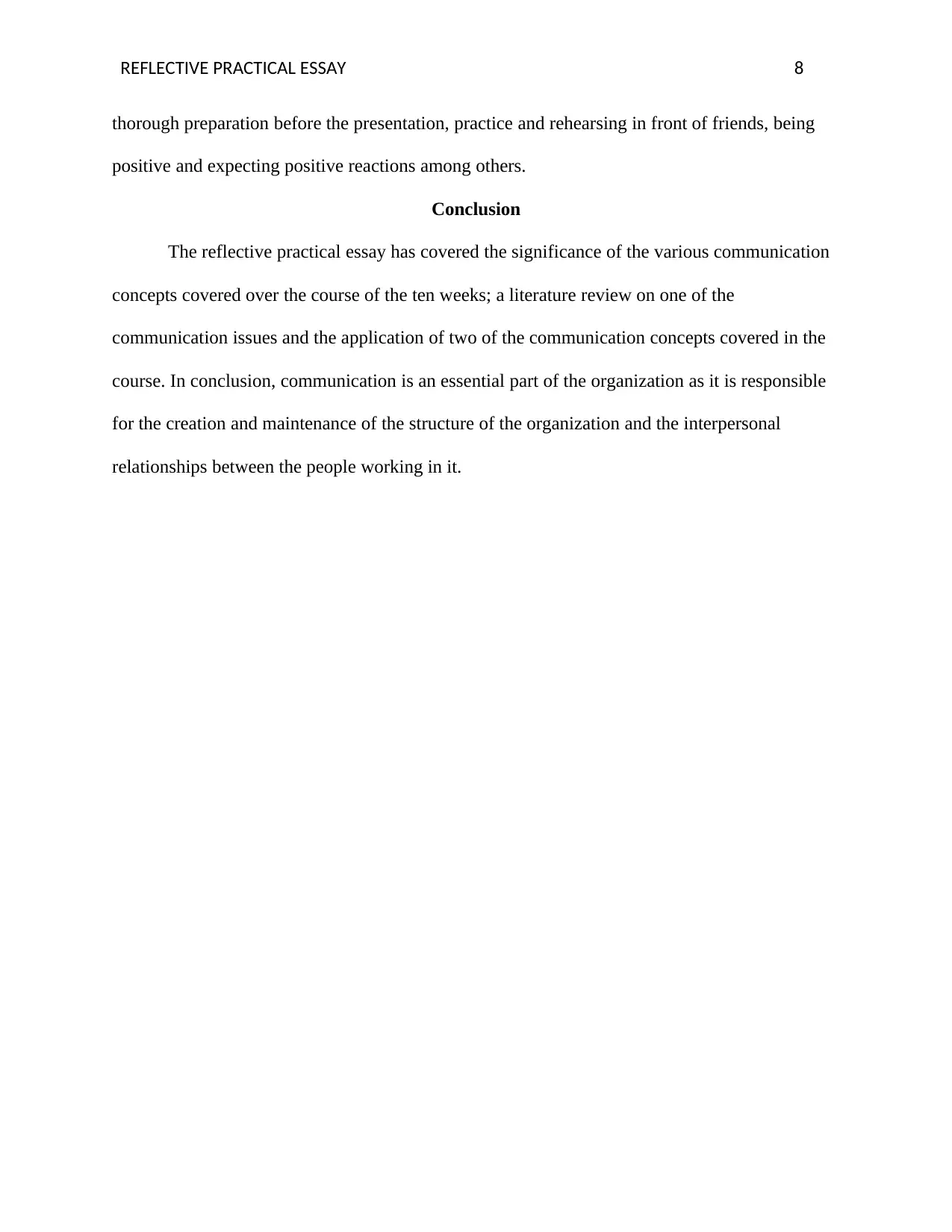
REFLECTIVE PRACTICAL ESSAY 8
thorough preparation before the presentation, practice and rehearsing in front of friends, being
positive and expecting positive reactions among others.
Conclusion
The reflective practical essay has covered the significance of the various communication
concepts covered over the course of the ten weeks; a literature review on one of the
communication issues and the application of two of the communication concepts covered in the
course. In conclusion, communication is an essential part of the organization as it is responsible
for the creation and maintenance of the structure of the organization and the interpersonal
relationships between the people working in it.
thorough preparation before the presentation, practice and rehearsing in front of friends, being
positive and expecting positive reactions among others.
Conclusion
The reflective practical essay has covered the significance of the various communication
concepts covered over the course of the ten weeks; a literature review on one of the
communication issues and the application of two of the communication concepts covered in the
course. In conclusion, communication is an essential part of the organization as it is responsible
for the creation and maintenance of the structure of the organization and the interpersonal
relationships between the people working in it.
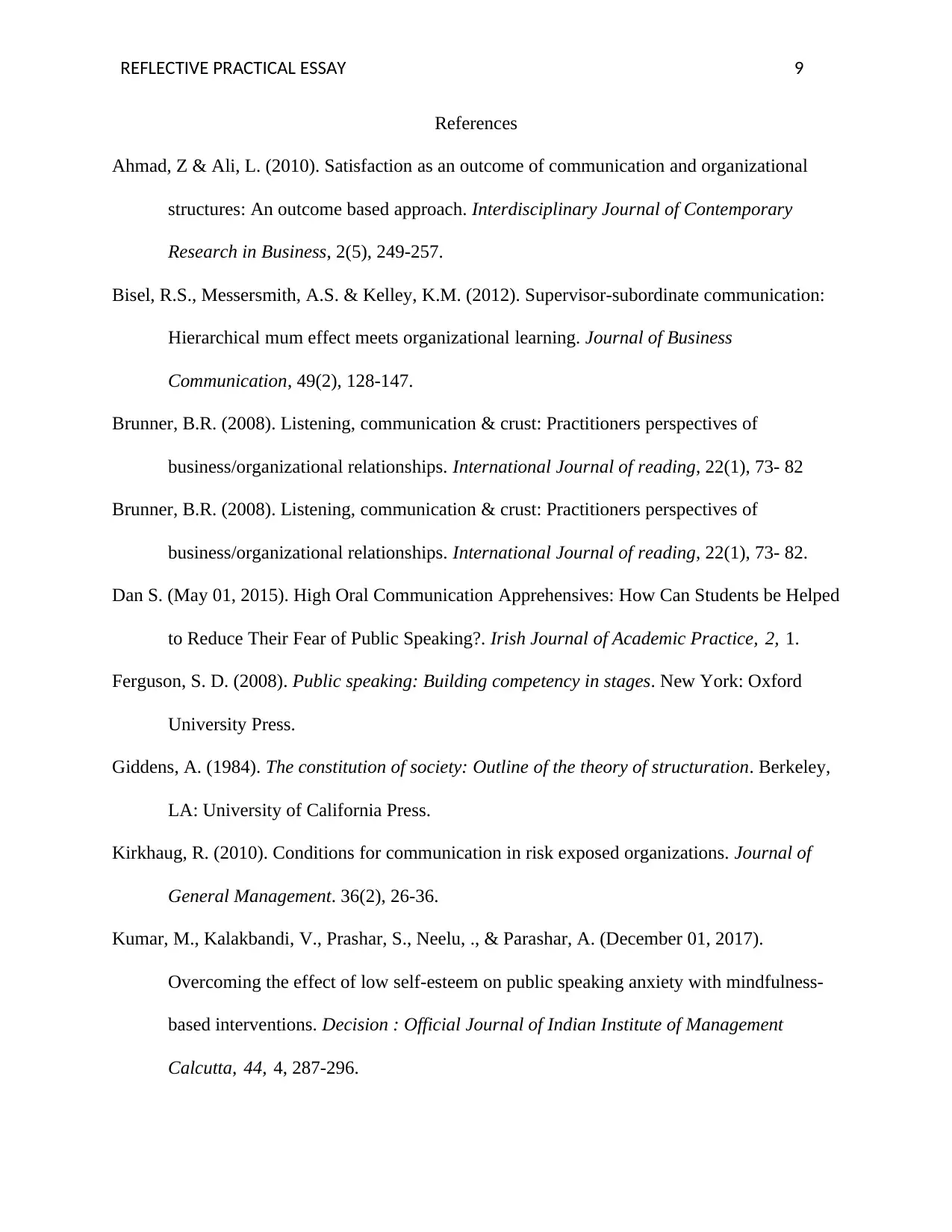
REFLECTIVE PRACTICAL ESSAY 9
References
Ahmad, Z & Ali, L. (2010). Satisfaction as an outcome of communication and organizational
structures: An outcome based approach. Interdisciplinary Journal of Contemporary
Research in Business, 2(5), 249-257.
Bisel, R.S., Messersmith, A.S. & Kelley, K.M. (2012). Supervisor-subordinate communication:
Hierarchical mum effect meets organizational learning. Journal of Business
Communication, 49(2), 128-147.
Brunner, B.R. (2008). Listening, communication & crust: Practitioners perspectives of
business/organizational relationships. International Journal of reading, 22(1), 73- 82
Brunner, B.R. (2008). Listening, communication & crust: Practitioners perspectives of
business/organizational relationships. International Journal of reading, 22(1), 73- 82.
Dan S. (May 01, 2015). High Oral Communication Apprehensives: How Can Students be Helped
to Reduce Their Fear of Public Speaking?. Irish Journal of Academic Practice, 2, 1.
Ferguson, S. D. (2008). Public speaking: Building competency in stages. New York: Oxford
University Press.
Giddens, A. (1984). The constitution of society: Outline of the theory of structuration. Berkeley,
LA: University of California Press.
Kirkhaug, R. (2010). Conditions for communication in risk exposed organizations. Journal of
General Management. 36(2), 26-36.
Kumar, M., Kalakbandi, V., Prashar, S., Neelu, ., & Parashar, A. (December 01, 2017).
Overcoming the effect of low self-esteem on public speaking anxiety with mindfulness-
based interventions. Decision : Official Journal of Indian Institute of Management
Calcutta, 44, 4, 287-296.
References
Ahmad, Z & Ali, L. (2010). Satisfaction as an outcome of communication and organizational
structures: An outcome based approach. Interdisciplinary Journal of Contemporary
Research in Business, 2(5), 249-257.
Bisel, R.S., Messersmith, A.S. & Kelley, K.M. (2012). Supervisor-subordinate communication:
Hierarchical mum effect meets organizational learning. Journal of Business
Communication, 49(2), 128-147.
Brunner, B.R. (2008). Listening, communication & crust: Practitioners perspectives of
business/organizational relationships. International Journal of reading, 22(1), 73- 82
Brunner, B.R. (2008). Listening, communication & crust: Practitioners perspectives of
business/organizational relationships. International Journal of reading, 22(1), 73- 82.
Dan S. (May 01, 2015). High Oral Communication Apprehensives: How Can Students be Helped
to Reduce Their Fear of Public Speaking?. Irish Journal of Academic Practice, 2, 1.
Ferguson, S. D. (2008). Public speaking: Building competency in stages. New York: Oxford
University Press.
Giddens, A. (1984). The constitution of society: Outline of the theory of structuration. Berkeley,
LA: University of California Press.
Kirkhaug, R. (2010). Conditions for communication in risk exposed organizations. Journal of
General Management. 36(2), 26-36.
Kumar, M., Kalakbandi, V., Prashar, S., Neelu, ., & Parashar, A. (December 01, 2017).
Overcoming the effect of low self-esteem on public speaking anxiety with mindfulness-
based interventions. Decision : Official Journal of Indian Institute of Management
Calcutta, 44, 4, 287-296.
⊘ This is a preview!⊘
Do you want full access?
Subscribe today to unlock all pages.

Trusted by 1+ million students worldwide
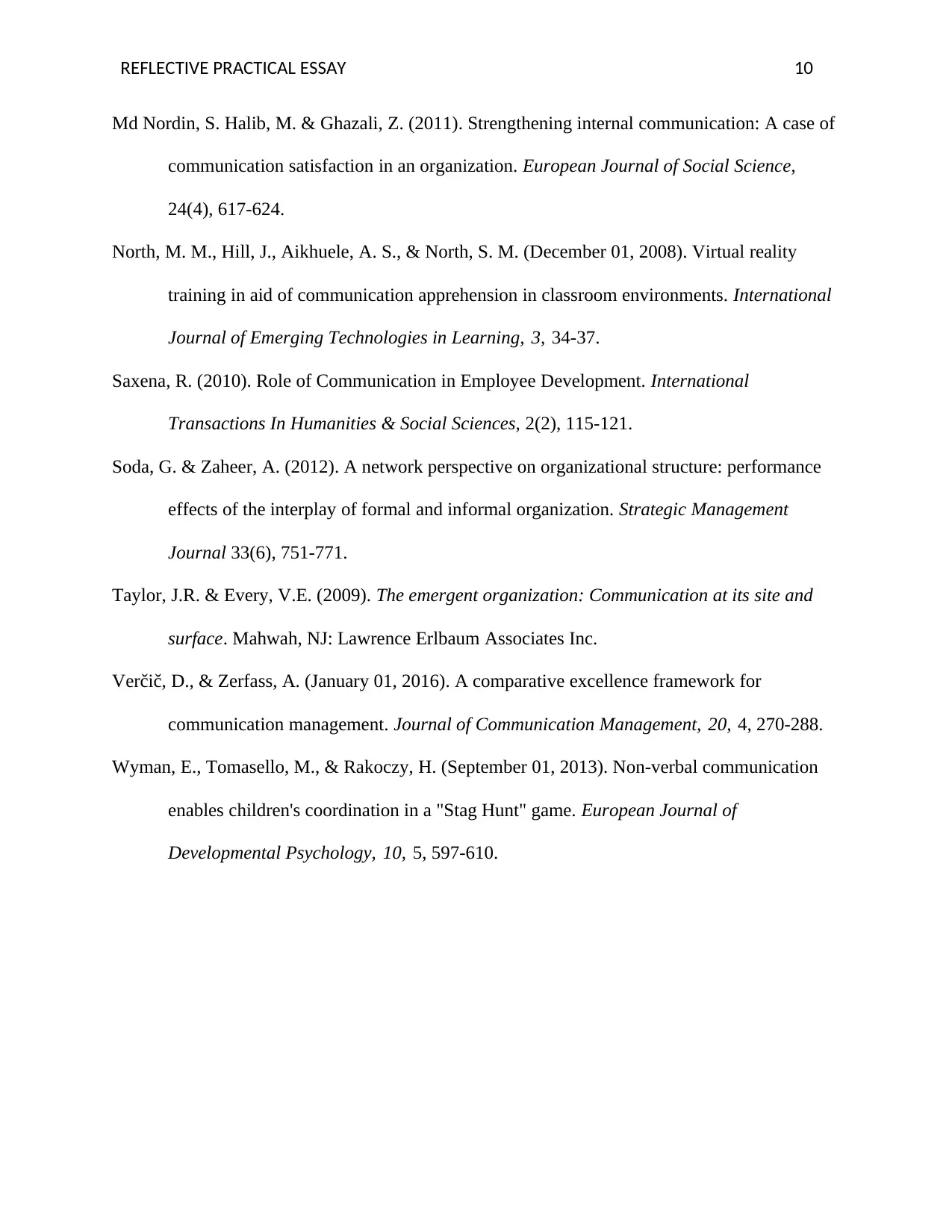
REFLECTIVE PRACTICAL ESSAY 10
Md Nordin, S. Halib, M. & Ghazali, Z. (2011). Strengthening internal communication: A case of
communication satisfaction in an organization. European Journal of Social Science,
24(4), 617-624.
North, M. M., Hill, J., Aikhuele, A. S., & North, S. M. (December 01, 2008). Virtual reality
training in aid of communication apprehension in classroom environments. International
Journal of Emerging Technologies in Learning, 3, 34-37.
Saxena, R. (2010). Role of Communication in Employee Development. International
Transactions In Humanities & Social Sciences, 2(2), 115-121.
Soda, G. & Zaheer, A. (2012). A network perspective on organizational structure: performance
effects of the interplay of formal and informal organization. Strategic Management
Journal 33(6), 751-771.
Taylor, J.R. & Every, V.E. (2009). The emergent organization: Communication at its site and
surface. Mahwah, NJ: Lawrence Erlbaum Associates Inc.
Verčič, D., & Zerfass, A. (January 01, 2016). A comparative excellence framework for
communication management. Journal of Communication Management, 20, 4, 270-288.
Wyman, E., Tomasello, M., & Rakoczy, H. (September 01, 2013). Non-verbal communication
enables children's coordination in a "Stag Hunt" game. European Journal of
Developmental Psychology, 10, 5, 597-610.
Md Nordin, S. Halib, M. & Ghazali, Z. (2011). Strengthening internal communication: A case of
communication satisfaction in an organization. European Journal of Social Science,
24(4), 617-624.
North, M. M., Hill, J., Aikhuele, A. S., & North, S. M. (December 01, 2008). Virtual reality
training in aid of communication apprehension in classroom environments. International
Journal of Emerging Technologies in Learning, 3, 34-37.
Saxena, R. (2010). Role of Communication in Employee Development. International
Transactions In Humanities & Social Sciences, 2(2), 115-121.
Soda, G. & Zaheer, A. (2012). A network perspective on organizational structure: performance
effects of the interplay of formal and informal organization. Strategic Management
Journal 33(6), 751-771.
Taylor, J.R. & Every, V.E. (2009). The emergent organization: Communication at its site and
surface. Mahwah, NJ: Lawrence Erlbaum Associates Inc.
Verčič, D., & Zerfass, A. (January 01, 2016). A comparative excellence framework for
communication management. Journal of Communication Management, 20, 4, 270-288.
Wyman, E., Tomasello, M., & Rakoczy, H. (September 01, 2013). Non-verbal communication
enables children's coordination in a "Stag Hunt" game. European Journal of
Developmental Psychology, 10, 5, 597-610.
1 out of 10
Related Documents
Your All-in-One AI-Powered Toolkit for Academic Success.
+13062052269
info@desklib.com
Available 24*7 on WhatsApp / Email
![[object Object]](/_next/static/media/star-bottom.7253800d.svg)
Unlock your academic potential
Copyright © 2020–2025 A2Z Services. All Rights Reserved. Developed and managed by ZUCOL.



